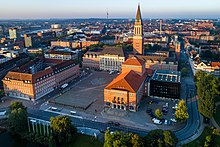
The Vienna State Opera is a historic opera house and opera company based in Vienna, Austria. The 1,709-seat Renaissance Revival venue was the first major building on the Vienna Ring Road. It was built from 1861 to 1869 following plans by August Sicard von Sicardsburg and Eduard van der Nüll, and designs by Josef Hlávka. The opera house was inaugurated as the "Vienna Court Opera" in the presence of Emperor Franz Joseph I and Empress Elisabeth of Austria. It became known by its current name after the establishment of the First Austrian Republic in 1921. The Vienna State Opera is the successor of the old Vienna Court Opera. The new site was chosen and the construction paid by Emperor Franz Joseph in 1861.
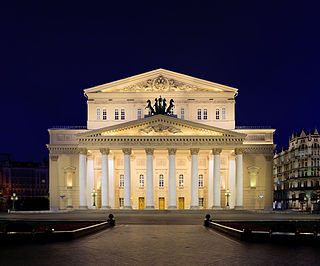
The Bolshoi Theatre is a historic opera house in Moscow, Russia, originally designed by architect Joseph Bové. Before the October Revolution it was a part of the Imperial Theatres of the Russian Empire along with Maly Theatre in Moscow and a few theatres in Saint Petersburg.

Malmö Opera is an opera house in Malmö, Sweden. An opera company of the same name presents seasons of opera in this house.

The Deutsche Oper Berlin is a German opera company located in the Charlottenburg district of Berlin. The resident building is the country's second largest opera house and also home to the Berlin State Ballet.

The National Theatre is a historic opera house in Prague, Czech Republic. It is known as the alma mater of Czech opera, and as the national monument of Czech history and art.

The Hungarian State Opera House is a historic opera house located in central Budapest, on Andrássy avenue. Originally known as the Hungarian Royal Opera House, it was designed by Miklós Ybl, a major figure of 19th-century Hungarian architecture. Construction began in 1875, funded by the city of Budapest and by Emperor Franz Joseph I of Austria-Hungary, and the new house opened to the public on the 27 September 1884. Before the closure of the "Népszínház" in Budapest, it was the third largest opera building in the city; today it is the second largest opera house in Budapest and in Hungary.
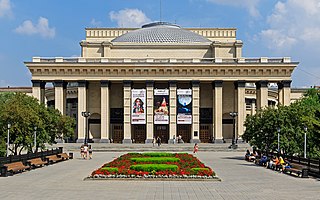
The Novosibirsk Opera and Ballet Theatre is a theatre in Novosibirsk and Siberia. It is located at the center of Novosibirsk at Lenin square.

The National Theatre is a theatre located in Belgrade, Serbia.

The Teatro Carlo Felice is the principal opera house of Genoa, Italy, used for performances of opera, ballet, orchestral music, and recitals. It is located on the side of Piazza De Ferrari.
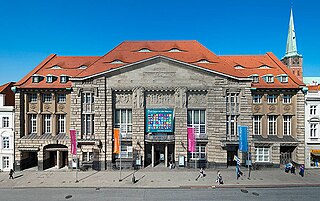
The Theater Lübeck is one of the largest theaters in the German state of Schleswig-Holstein. It is managed by Theater Lübeck GmbH, a state-owned company of the Hansestadt Lübeck.

Theater Dortmund is a theatrical organization that produces operas, musicals, ballets, plays, and concerts in Dortmund, Germany. It was founded as the Stadttheater Dortmund in 1904. Supported by the German Government, the organization owns and operates several performance spaces.

Musiktheater im Revier (MiR) is the venue for performing opera, operetta, musical theatre and ballet in Gelsenkirchen, Germany. It opened on 15 December 1959; it is listed since 1997 as a protected cultural monument.

The Latvian National Opera and Ballet (LNOB) is an opera house and opera company at Aspazijas boulevard 3 in Riga. Its repertoire includes performances of opera and ballet presented during the season which lasts from mid-September to the end of May. During a typical season, LNOB presents almost 200 performances, including, on average, 6 new productions. The largest is the Great Hall which houses 946 seats, while the smaller ones – the New Hall, the Dress Circle Hall (Beletāžas zāle) and the Red Hall – have a maximum seating capacity of 338, 170 and 100 respectively. LNOB employs a total of approximately 600 people. The building is located on the bank of the Riga Canal, near the Freedom Monument. As of 5 November 2019, the chairman of the board is Egils Siliņš, a world renowned opera singer. The chief conductor since 2013 is Mārtiņš Ozoliņš who is also an associate professor at the Jāzeps Vītols Latvian Academy of Music. The artistic director since 1993 is Aivars Leimanis.

Theater Freiburg is a theatre in Baden-Württemberg, Germany.

The Theater des Westens is one of the most famous theatres for musicals and operettas in Berlin, Germany, located at Kantstraße 10–12 in Charlottenburg. It was founded in 1895 for plays. The present house was opened in 1896 and dedicated to opera and operetta. Enrico Caruso made his debut in Berlin here, and the Ballets Russes appeared with Anna Pavlova. In the 1930s it was run as the Volkstheater Berlin. After World War II it served as the temporary opera house of Berlin, the Städtische Oper. In 1961 it became the first theatre in Germany to show musicals. Since then it has become the "German equivalent of Broadway extravaganzas", putting on plays and musical comedies.

Theater Kiel is a theatre company in Kiel, the capital of Schleswig-Holstein, Germany. It is jointly funded by the city and the state. The company produces opera, musical, ballet, plays, and theatre for youth and children, in three different buildings: the Opernhaus, the Schauspielhaus, and the Theater im Werftpark.

Stadttheater Magdeburg was the municipal theatre of Magdeburg, Germany. It was opened in 1878, was at times of national importance for operas, and was destroyed during World War II.

Anhaltisches Theater Dessau is a theatre in Dessau, Saxony-Anhalt, Germany, which was called Landestheater Dessau until 1984. It is Mehrspartentheater offering drama, musical theatre, ballets, concerts of the Anhaltische Philharmonie orchestra, and puppetry.
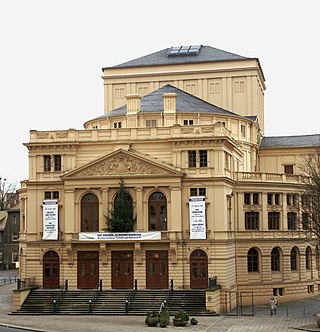
The Landestheater Altenburg is a multi-part theatre in Altenburg and part of the Theater Altenburg-Gera. The venues used are the Großes Haus with 500 seats as well as the Heizhaus and the Theater unterm Dach. The general director and managing director since 2011 is Kay Kuntze.
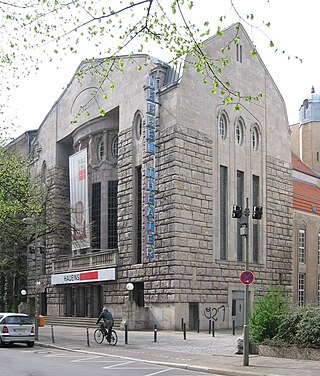
The Hebbel-Theater is a historic theatre building for plays in Berlin-Kreuzberg, Germany. It has been a venue of the company Hebbel am Ufer (HAU) from 2003.


